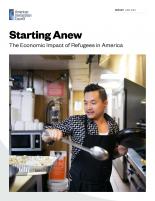- Special Report
Starting Anew
The Economic Impact of Refugees in America
Published
A record 100 million people around the globe were forced to flee their homes in 2022, up from 65 million in 2015. Of those displaced last year, 32.5 million were refugees who had to leave their country in fear of persecution due to their race, religion, nationality, political opinion or group membership. While the United States set its refugee admissions target at 125,000 for 2023, today’s global crises are increasing the demand upon that number. In addition to regular refugee admissions, the United States has let in nearly 180,000 Afghans and Ukrainians through humanitarian parole since 2021.
Political debates on how to handle recent refugees often focus on questions of humanitarian obligation or public safety concerns. While these are critical considerations, they fail to capture what many Americans experience as the most enduring legacy of refugees: the positive social and economic impact these newcomers have on their cities and towns.
Across the country, refugees have reshaped many communities in a fundamental way. In Fargo, North Dakota, large-scale employers like glass manufacturer Cardinal IG and rural health provider Sanford Health say they could not have successfully sustained and expanded operations in the region without the influx of refugee workers. In Minneapolis, Somali refugees have become such an integral part of the city’s business and cultural landscape that one now represents the area in the U.S. Congress. And in Buffalo, New York, the “refugee renaissance” has been credited with reversing decades of population decline and turning neighborhoods abandoned by the exodus of factory work into areas that are now safe and lively. These are just a few examples of the very real ways in which refugees affect not just our society but also our local economy.
This report builds on the previous work published by New American Economy (now a part of the American Immigration Council) and provides updated analyses of how recent refugees are contributing to the U.S. economy. Using the 5-year American Community Survey (ACS) from 2019, we identify a pool of nearly 2.4 million likely refugees based on their country of origin and year of arrival in the United States. This method is conservative in nature but provides us with a large and representative picture of the 3.5 million refugees who have arrived since 1975. The results our work produces are clear. Refugees pay tens of billions of dollars in taxes each year. And in a country where immigrants have long been known to be more likely than the U.S.-born to start businesses, refugees show a particular willingness to make such long-term investments in the country. They found companies, become U.S. citizens, and buy homes at notably high rates.
- Refugees make significant contributions to our economy as earners and taxpayers.
- In 2019, the almost 2.4 million refugees captured in our analysis earned a collective $93.6 billion in household income. They also contributed $25 billion in taxes. That left them with $68.6 billion in disposable income, or spending power, to use at U.S. businesses.
- While refugees receive initial assistance upon arriving in the United States, they see particularly sharp income increases in subsequent years.
- While refugees here for five years or less have a median household income of roughly $30,500, that figure rises in the following decades. By the time a refugee has been in the country for at least 20 years, their median household income reaches $71,400—$4,300 more than the median income of U.S. households overall.
- Refugees have an entrepreneurship rate that outshines even that of other immigrants.
- The United States was home to nearly 188,000 refugee entrepreneurs in 2019. That means that 13 percent of refugees were entrepreneurs, compared to just 11.7 percent of non-refugee immigrants and 9 percent of the U.S.-born population. Refugee entrepreneurs also generated $5.1 billion in business income that year.
- Refugees make particularly meaningful contributions to the economiesof several large states.
- In 17 U.S. states—including North Carolina, Michigan, and Massachusetts—the likely refugees in our sample hold more than $1 billion in spending power. In California alone, their spending power totals more than $20.7 billion, while in Texas the equivalent figure is more than $5.4 billion.
- Even more than other immigrants, refugees take steps to lay down roots and build lives in America.
- Of refugees who have been in the country for 20 years or more, 89.9 percent have become citizens, compared with 67.5 percent of other immigrants in the country that long. Additionally, 59.2 percent of all likely refugee households own their homes, compared with 51.7 percent of other immigrants. The homeownership rate for U.S.-born residents is 65.7 percent.
- In an era when the country faces unprecedented demographic challenges, refugees are uniquely positioned to help.
- Recent estimates have indicated that by 2040, 21.6 percent of the U.S. population will be age 65 or older—up from 16 percent in 2019—while the 85 and older population doubles. Refugees can help lessen the anticipated strain this will place on our workforce and entitlement programs. An estimated 78.2 percent of refugees are working-age, compared with 61.9 percent of the U.S.-born population.
Help us fight for immigration justice!
The research is clear – immigrants are more likely to win their cases with a lawyer by their side. But very few can get attorneys.
Introducing the Immigration Justice Campaign Access Fund.
Your support sends attorneys, provides interpreters, and delivers justice.

Immigration Justice Campaign is an initiative of American Immigration Council and American Immigration Lawyers Association. The mission is to increase free legal services for immigrants navigating our complicated immigration system and leverage the voices and experiences of those most directly impacted by our country’s immigration policies to inform legal and advocacy strategies. We bring together a broad network of volunteers who provide legal assistance and advocate for due process for immigrants with a humane approach that includes universal legal representation and other community-based support for individuals during their immigration cases.

